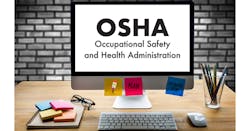The deadline for employers to prepare, certify and post a hard copy of their 300A annual summary of injuries and illnesses report in their workplaces for employees to see is Feb. 1—unless your business is excluded because you have fewer than 10 employees or are on a list of low-hazard industries, such as dental offices, advertising services and car dealers.
These are hard copy reports meant to be posted in the workplace for employees to see. Employers in certain other industries must electronically file their reports for 2018 with the Occupational Safety and Health Administration (OSHA) no later than March 2.
Also, keep in mind that because of an agreement reached between Congress and President Trump last September, OSHA and all other agencies operating under the umbrella of the Department of Labor continue to function under the partial government shutdown.
The Form 300A is a summation of the workplace injuries and illnesses recorded on the OSHA 300 Log during the previous calendar year, as well as the total hours worked that year by all employees covered by the OSHA 300 Log. By Feb. 1 employers must review their OSHA 300 Logs, verify the entries on the 300 Log are complete and accurate, and correct any deficiencies discovered.
The employer then must use the injury data from the 300 Log to calculate an annual summary of injuries and illnesses and complete the 300A Annual Summary Form, and certify the accuracy of the 300 Log and the 300A Summary Form.
With the many changes made in the reporting process over recent years, employers need to avoid making some of the most common mistakes, according to attorneys Lindsay DiSalvo, Daniel Deacon and Eric Conn of the law firm of Conn Maciel Carey LLP. “We frequently see employers make mistakes related to this annual duty to prepare, post and certify the injury and illness recordkeeping summary.”
Some regularly made mistakes include
● Not having a management representative with high enough status within the company “certify” the 300A.
● Not posting a 300A for years in which there were no recordable injuries.
● Not maintaining a copy of the certified version of the 300A form.
● Not updating prior years’ 300 Logs based on newly discovered information about previously unrecorded injuries or changes to injuries previously recorded.
● Confusing the requirement to Post a 300A in the workplace with the requirement to electronically submit 300A data to OSHA’s web portal.
How to Do It Right
“A common mistake employers make is to have a management representative sign the 300A Form who is not at a senior enough level in the company to constitute a ‘company executive,’” the lawyers note. This is defined as an owner of the company, a corporate officer, the highest-ranking company official working at the workplace, or the immediate supervisor of the highest-ranking company official at that location.
After certifying the 300A, OSHA’s regulations require the certified copy of the 300A Summary Form be posted in the workplace for three months, through April 30. The attorneys point out that many employers fail to prepare or post a 300A Form in years when there were no recordable injuries or illnesses.
“Even when there have been no recordable injuries, OSHA regulations still require employers to complete the 300A form, entering zeroes into each column total, and to post the 300A just the same,” warn the Conn Maciel Carey lawyers.
After April 30, employers may take down the 300A Form, but must maintain for five years following the end of the prior calendar year at the facility covered by the form or at a central location, a copy of the underlying OSHA 300 Log, the certified 300A Annual Summary Form and any corresponding 301 Incident Report forms.
Another common mistake made by employers is to keep only the electronic version of the 300A, and not the version that was printed, “certified” typically by a handwritten signature and posted at the facility. “Accordingly, those employers have no effective way to demonstrate to OSHA during an inspection or enforcement action that the 300A had been certified,” the attorneys observe.
Another thing employers want to avoid is putting away old 300 Logs and never looking back, even if new information comes to light about injuries recorded on those logs. However, OSHA’s recordkeeping regulations require employers during the five-year retention period to update OSHA 300 Logs with newly discovered recordable injuries or illnesses, or to correct previously recorded injuries and illnesses to reflect changes that have occurred in the classification or other details.
This requirement applies only to the 300 Logs and as a result technically there is no duty to update 300A Forms or OSHA 301 Incident Reports.
About the Author

David Sparkman
David Sparkman is founding editor of ACWI Advance, the newsletter of the American Chain of Warehouses Inc. He also heads David Sparkman Consulting, a Washington, D.C. area public relations and communications firm. Prior to these he was director of industry relations for the International Warehouse Logistics Association. Sparkman has also been a freelance writer, specializing in logistics and freight transportation. He has served as vice president of communications for the American Moving and Storage Association, director of communications for the National Private Truck Council, and for two decades with American Trucking Associations on its weekly newspaper, Transport Topics.
